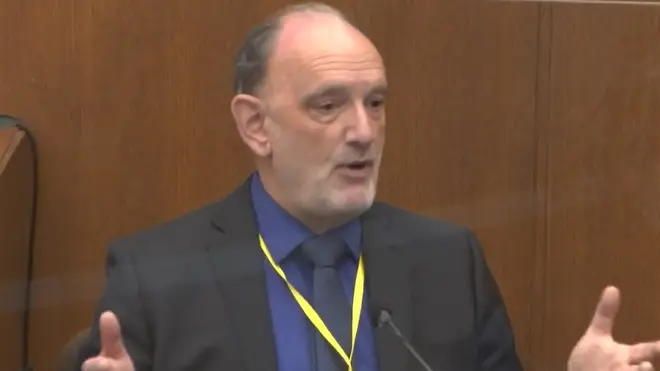
Nick Abbot 10pm - 1am
14 April 2021, 17:34

Derek Chauvin is on trial on charges of murder and manslaughter over Mr Floyd’s death in Minneapolis.
George Floyd died of a sudden heart rhythm problem due to his heart disease while being restrained by police, a retired forensic pathologist has told former officer Derek Chauvin’s murder trial.
The evidence from Dr David Fowler, a former chief medical examiner for the state of Maryland and now a member of a consulting firm, contradicted several experts who said Mr Floyd succumbed to a lack of oxygen.
Dr Fowler said that the fentanyl and methamphetamine in Mr Floyd’s system, and possible carbon monoxide poisoning from a car exhaust, were contributing factors.
He said Mr Floyd’s heart disease included high blood pressure and narrowing of the arteries.

“All of those combined to cause Mr Floyd’s death,” he said on the second day of the defence case.
Chauvin lawyer Eric Nelson is trying to prove that the 19-year Minneapolis police veteran did what he was trained to do and that Mr Floyd died because of his illegal drug use and underlying health problems.
Prosecutors say Mr Floyd died because Chauvin’s knee was pressed into Mr Floyd’s neck or neck area for nine-and-a-half minutes as the 46-year-old black man lay pinned to the pavement on his stomach last May with his hands cuffed behind his back.
Several top Minneapolis police officials, including the police chief, have given evidence saying that Chauvin used excessive force and violated his training.
And a number of medical experts called by prosecutors have said that Mr Floyd died from a lack of oxygen because the way he was restrained restricted his breathing.
However, the chief county medical examiner who ruled Mr Floyd’s death a homicide, Dr Andrew Baker, did not identify lack of oxygen, or asphyxia, as the cause of death.
When he took to the witness box for the prosecution, he said that Mr Floyd had severe underlying heart disease and an enlarged heart, and that the way he was held down and his neck compressed was more than Mr Floyd’s heart could take.
Dr Fowler handled a case similar to Mr Floyd’s in Maryland in 2018, when a 19-year-old black man, Anton Black, died after three officers and a civilian pinned him for more than five minutes as they handcuffed him and shackled his legs.

The family brought a federal lawsuit that included Dr Fowler, whose post-mortem examination found that the stress of the struggle probably contributed to Mr Black’s death but found no evidence that restraint directly caused it.
It also found no evidence of asphyxia.
Chauvin, a 45-year-old white man, is on trial on charges of murder and manslaughter over Mr Floyd’s death after his arrest on suspicion of passing a counterfeit 20 dollar note at a neighbourhood market.
The defence has not said whether Chauvin will give evidence.
Such a move could open him up to devastating cross-examination, with prosecutors replaying the video of Mr Floyd’s arrest and forcing Chauvin, one freeze-frame moment at a time, to explain why he kept pressing down on Mr Floyd.
But it could also give the jury the opportunity to see and hear any remorse or sympathy Chauvin might feel.
It would give jurors a good look at his face; he has had to wear a Covid-19 mask while seated at the defence table.
The only time Chauvin has been heard publicly defending himself was when the jury listened to body-camera footage from the scene.
After an ambulance had taken Mr Floyd away, Chauvin was heard telling a bystander: “We gotta control this guy ’cause he’s a sizable guy … and it looks like he’s probably on something.”
Earlier on Wednesday, Judge Peter Cahill turned down a defence request to acquit Chauvin, rejecting claims that prosecutors failed to prove Chauvin’s actions killed Mr Floyd.
Requests for an acquittal are routinely made midway through a trial and are usually denied.